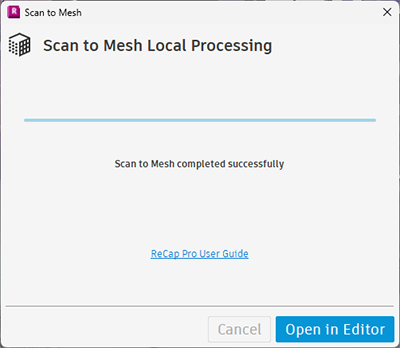Generating a Mesh Model
When the Scan to Mesh dialog opens, determine the new mesh name.
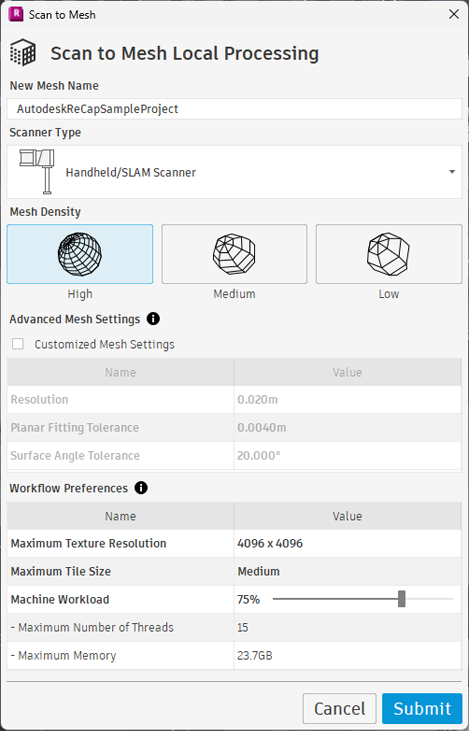
Preset mesh settings
To make the meshing process as easy as possible, a set of preset meshing profiles are available that are optimized for a variety of different types of scanning hardware. Choose your scanner type from the drop-down menu:
- Handheld/SLAM
- Wearable/SLAM
- Terrestrial Laser Scanner
- Vehicle/SLAM
- Aerial LIDAR/Photogrammetry
The different scanner types adjust the mesh settings to better suit the point cloud characteristics of each type. Ground based, static LIDAR typically produces a denser, less noisy point cloud compared to ground based mobile LIDAR. Aerial and vehicle capture typically produces point clouds with lower density that ground based LIDAR. Therefore choosing the right scanner type will have a big effect on the mesh quality.
Refer to Best Practices for Scan to Mesh Settings for discovering the correct mesh settings.
If a point cloud was captured using a different methodology, custom settings are available below.
Each scanner type has a set of different Mesh Density to choose from:
- Low
- Medium
- High
Choosing a higher level of detail will result in longer processing times and a higher density mesh.
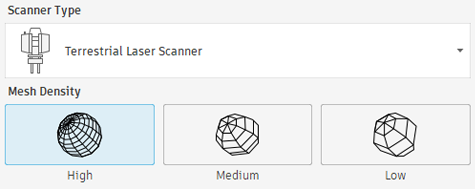
Advanced mesh settings
To modify the 3 preset mesh settings, select the Customized Mesh Settings option.
Resolution. Defines the size of the smallest triangle. Smaller valued result in smaller triangles and more details being modelled.
Important: This value should always be set higher than the point density of the point cloud.Planar Fitting Tolerance. Reduces triangulation on flat surfaces. Set to 1/5th of resolution as default. A smaller value reduces optimization, resulting in more triangles and more details being modeled.
Surface Angle Tolerance. Specifies the segmentation setting. Set between 18°-22° for optimal results. A lower value increases segmentation.
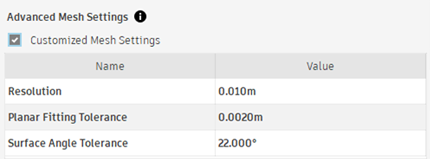
Workflow Preferences
The workflow preferences control how the mesh models will look and how much computer resources are used during the meshing process.
- Maximum Texture Resolution. Choose the size of the RGB and Intensity texture files for the mesh model. Large sizes result in better quality texture and a larger file size.
- Maximum Tile Size. Defines the size of the mesh subset tiles that will be created. Supertiles are created to manage mesh file size and texture quality. Smaller tile sizes result in better quality textures.
- Machine Workload. Sets the amount of computer resources that the scan to mesh process will allocate. Note that the RAM utilization is an estimate.
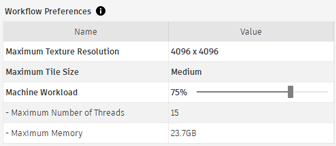
Click Submit to start the scan to mesh process.
Progress information
Progress information will appear once the scan to mesh process begins. The status bar cycles through 3 main stages:
- Assigning points to tiles. The ReCap point cloud is tiled into chunks that will be processed in parallel.
- Converting tiles. Point cloud tiles convert to mesh tiles.
- Generating supertiles. Assembles the mesh tiles into larger tiles that are easier to work with. The number of tiles being generated will be indicated at this stage.
Once the meshing process completes, the progress information window notifies success.
Click Open in Editor to launch the Mesh Editor and view the result.
